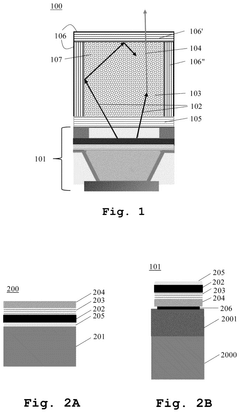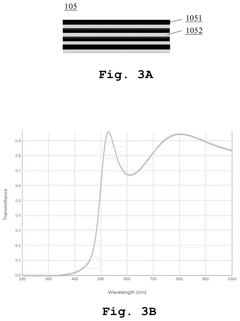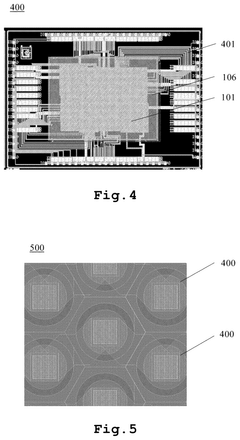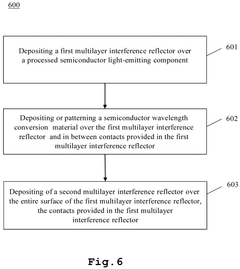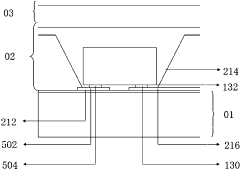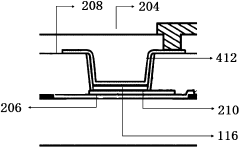ULED Breakthroughs in User‑Centric Design
JUN 20, 20259 MIN READ
Generate Your Research Report Instantly with AI Agent
Patsnap Eureka helps you evaluate technical feasibility & market potential.
ULED Evolution and Objectives
User-centric LED (ULED) technology has emerged as a revolutionary approach in lighting design, focusing on enhancing user experience and well-being. The evolution of ULED can be traced back to the early 2010s when researchers began exploring ways to optimize LED lighting for human comfort and productivity.
Initially, ULED development concentrated on improving color rendering and reducing blue light emissions to mitigate potential health risks associated with prolonged exposure to artificial lighting. As the technology progressed, researchers expanded their focus to include adaptive lighting systems that could adjust color temperature and intensity based on circadian rhythms and ambient conditions.
A significant milestone in ULED evolution was the integration of smart sensors and control systems, enabling lighting to respond dynamically to user presence, activities, and preferences. This marked a shift from static lighting solutions to interactive, personalized environments that could enhance mood, productivity, and overall well-being.
The objectives of ULED technology have evolved in tandem with advancements in the field. Current goals include developing lighting systems that can seamlessly integrate with IoT ecosystems, providing users with intuitive control over their lighting environment through voice commands, mobile apps, and gesture recognition.
Another key objective is to improve energy efficiency without compromising on light quality or user experience. Researchers are exploring advanced materials and optical designs to maximize lumens per watt while maintaining optimal color rendering and distribution characteristics.
ULED technology also aims to address the growing demand for biophilic design in built environments. This involves creating lighting solutions that mimic natural daylight patterns, supporting human circadian rhythms and promoting a connection with nature in indoor spaces.
As ULED technology continues to advance, a primary objective is to develop more sophisticated algorithms for predictive lighting. These systems would anticipate user needs based on historical data, environmental factors, and real-time inputs, creating truly responsive and intuitive lighting environments.
Looking ahead, the ULED field is set to explore the integration of augmented reality (AR) and virtual reality (VR) technologies with lighting systems. This convergence could lead to immersive lighting experiences that blur the lines between physical and digital environments, opening up new possibilities for entertainment, education, and therapeutic applications.
Initially, ULED development concentrated on improving color rendering and reducing blue light emissions to mitigate potential health risks associated with prolonged exposure to artificial lighting. As the technology progressed, researchers expanded their focus to include adaptive lighting systems that could adjust color temperature and intensity based on circadian rhythms and ambient conditions.
A significant milestone in ULED evolution was the integration of smart sensors and control systems, enabling lighting to respond dynamically to user presence, activities, and preferences. This marked a shift from static lighting solutions to interactive, personalized environments that could enhance mood, productivity, and overall well-being.
The objectives of ULED technology have evolved in tandem with advancements in the field. Current goals include developing lighting systems that can seamlessly integrate with IoT ecosystems, providing users with intuitive control over their lighting environment through voice commands, mobile apps, and gesture recognition.
Another key objective is to improve energy efficiency without compromising on light quality or user experience. Researchers are exploring advanced materials and optical designs to maximize lumens per watt while maintaining optimal color rendering and distribution characteristics.
ULED technology also aims to address the growing demand for biophilic design in built environments. This involves creating lighting solutions that mimic natural daylight patterns, supporting human circadian rhythms and promoting a connection with nature in indoor spaces.
As ULED technology continues to advance, a primary objective is to develop more sophisticated algorithms for predictive lighting. These systems would anticipate user needs based on historical data, environmental factors, and real-time inputs, creating truly responsive and intuitive lighting environments.
Looking ahead, the ULED field is set to explore the integration of augmented reality (AR) and virtual reality (VR) technologies with lighting systems. This convergence could lead to immersive lighting experiences that blur the lines between physical and digital environments, opening up new possibilities for entertainment, education, and therapeutic applications.
User-Centric ULED Market Analysis
The ULED (Ultra Light Emitting Diode) market has witnessed significant growth in recent years, driven by the increasing demand for high-quality display technologies across various industries. As user-centric design becomes a paramount focus in product development, the ULED market is experiencing a shift towards more personalized and intuitive display solutions.
Consumer electronics, particularly smartphones and televisions, represent the largest segment of the ULED market. The demand for thinner, lighter, and more energy-efficient devices has propelled the adoption of ULED technology. In the smartphone sector, manufacturers are leveraging ULED displays to offer enhanced visual experiences, improved color accuracy, and reduced power consumption, aligning with user preferences for longer battery life and immersive viewing.
The automotive industry is emerging as a rapidly growing market for ULED technology. As vehicles become more connected and autonomous, there is an increasing need for advanced display systems that can provide clear, bright, and customizable information to drivers and passengers. ULED displays are being integrated into dashboard systems, infotainment units, and heads-up displays, offering improved visibility and user interaction.
In the commercial and retail sectors, ULED technology is revolutionizing digital signage and advertising displays. The superior brightness, contrast, and color reproduction of ULED panels enable businesses to create more engaging and eye-catching visual content, enhancing the overall user experience in retail environments, public spaces, and entertainment venues.
The healthcare industry is also adopting ULED technology for medical imaging and diagnostic equipment. The high resolution and accurate color reproduction of ULED displays contribute to improved diagnostic accuracy and patient care. This application demonstrates the versatility of ULED technology in meeting specialized user needs across different sectors.
As user expectations continue to evolve, the ULED market is responding with innovations in flexible and foldable display technologies. These advancements cater to the growing demand for more versatile and adaptable devices, allowing users to customize their viewing experiences based on their preferences and usage scenarios.
The global ULED market is projected to experience substantial growth in the coming years, driven by technological advancements and increasing user demand for superior display quality. As manufacturers continue to focus on user-centric design principles, we can expect to see further innovations in ULED technology that address specific user needs and preferences across various industries and applications.
Consumer electronics, particularly smartphones and televisions, represent the largest segment of the ULED market. The demand for thinner, lighter, and more energy-efficient devices has propelled the adoption of ULED technology. In the smartphone sector, manufacturers are leveraging ULED displays to offer enhanced visual experiences, improved color accuracy, and reduced power consumption, aligning with user preferences for longer battery life and immersive viewing.
The automotive industry is emerging as a rapidly growing market for ULED technology. As vehicles become more connected and autonomous, there is an increasing need for advanced display systems that can provide clear, bright, and customizable information to drivers and passengers. ULED displays are being integrated into dashboard systems, infotainment units, and heads-up displays, offering improved visibility and user interaction.
In the commercial and retail sectors, ULED technology is revolutionizing digital signage and advertising displays. The superior brightness, contrast, and color reproduction of ULED panels enable businesses to create more engaging and eye-catching visual content, enhancing the overall user experience in retail environments, public spaces, and entertainment venues.
The healthcare industry is also adopting ULED technology for medical imaging and diagnostic equipment. The high resolution and accurate color reproduction of ULED displays contribute to improved diagnostic accuracy and patient care. This application demonstrates the versatility of ULED technology in meeting specialized user needs across different sectors.
As user expectations continue to evolve, the ULED market is responding with innovations in flexible and foldable display technologies. These advancements cater to the growing demand for more versatile and adaptable devices, allowing users to customize their viewing experiences based on their preferences and usage scenarios.
The global ULED market is projected to experience substantial growth in the coming years, driven by technological advancements and increasing user demand for superior display quality. As manufacturers continue to focus on user-centric design principles, we can expect to see further innovations in ULED technology that address specific user needs and preferences across various industries and applications.
ULED Technical Challenges
ULED (Ultra Light Emitting Diode) technology faces several significant technical challenges in its pursuit of user-centric design breakthroughs. One of the primary obstacles is achieving uniform light distribution across the display surface. The miniaturization of LEDs to micro and nano scales introduces complexities in maintaining consistent brightness and color accuracy, particularly at varying viewing angles.
Another critical challenge lies in the thermal management of ULED displays. As pixel density increases and individual LEDs shrink, heat dissipation becomes a crucial factor. Excessive heat can lead to reduced lifespan, color shifts, and potential safety concerns. Developing efficient heat sinking mechanisms without compromising the ultra-thin profile of ULED displays remains a significant hurdle.
The manufacturing process for ULEDs also presents considerable challenges. Achieving high yield rates in the production of microscopic LEDs requires advanced fabrication techniques and stringent quality control measures. The transfer and placement of these tiny LEDs onto display substrates with precision is a complex task that demands innovative solutions in mass transfer technology.
Power efficiency is another area of focus in ULED development. While LEDs are generally energy-efficient, the drive for higher brightness and resolution in user-centric designs necessitates further improvements in power consumption. Balancing power efficiency with performance is crucial for the widespread adoption of ULED technology, especially in mobile and wearable devices.
Color management presents yet another challenge. Achieving a wide color gamut and accurate color reproduction across the entire display requires sophisticated color calibration techniques and advanced materials science. The development of phosphors and quantum dots that can deliver pure, vibrant colors while maintaining long-term stability is an ongoing area of research.
Lastly, the integration of touch functionality and other interactive features into ULED displays poses additional technical hurdles. Incorporating touch sensors without compromising display quality or increasing overall thickness requires innovative design approaches and materials.
Addressing these technical challenges is crucial for realizing the full potential of ULED technology in user-centric design. Overcoming these obstacles will pave the way for displays that offer superior visual quality, energy efficiency, and interactive capabilities, ultimately enhancing the user experience across a wide range of applications.
Another critical challenge lies in the thermal management of ULED displays. As pixel density increases and individual LEDs shrink, heat dissipation becomes a crucial factor. Excessive heat can lead to reduced lifespan, color shifts, and potential safety concerns. Developing efficient heat sinking mechanisms without compromising the ultra-thin profile of ULED displays remains a significant hurdle.
The manufacturing process for ULEDs also presents considerable challenges. Achieving high yield rates in the production of microscopic LEDs requires advanced fabrication techniques and stringent quality control measures. The transfer and placement of these tiny LEDs onto display substrates with precision is a complex task that demands innovative solutions in mass transfer technology.
Power efficiency is another area of focus in ULED development. While LEDs are generally energy-efficient, the drive for higher brightness and resolution in user-centric designs necessitates further improvements in power consumption. Balancing power efficiency with performance is crucial for the widespread adoption of ULED technology, especially in mobile and wearable devices.
Color management presents yet another challenge. Achieving a wide color gamut and accurate color reproduction across the entire display requires sophisticated color calibration techniques and advanced materials science. The development of phosphors and quantum dots that can deliver pure, vibrant colors while maintaining long-term stability is an ongoing area of research.
Lastly, the integration of touch functionality and other interactive features into ULED displays poses additional technical hurdles. Incorporating touch sensors without compromising display quality or increasing overall thickness requires innovative design approaches and materials.
Addressing these technical challenges is crucial for realizing the full potential of ULED technology in user-centric design. Overcoming these obstacles will pave the way for displays that offer superior visual quality, energy efficiency, and interactive capabilities, ultimately enhancing the user experience across a wide range of applications.
Current User-Centric ULED Solutions
01 ULED structure and materials
Ultra Light Emitting Diodes (ULEDs) utilize advanced semiconductor materials and structures to achieve high efficiency and brightness. The design focuses on optimizing the active layer, electrode configuration, and substrate materials to enhance light output and reduce power consumption. Novel manufacturing techniques are employed to create ultra-thin and flexible ULED devices.- ULED structure and fabrication: Ultra Light Emitting Diodes (ULEDs) are designed with advanced structures to enhance light emission efficiency and reduce power consumption. The fabrication process involves innovative techniques to create ultra-thin and highly efficient light-emitting layers. These improvements contribute to the overall performance and user experience of ULED devices.
- User-centric display design: ULED displays are engineered with user-centric approaches, focusing on factors such as visual comfort, color accuracy, and reduced eye strain. The design incorporates adaptive brightness control, blue light filtering, and optimized pixel arrangements to enhance the viewing experience across various lighting conditions and usage scenarios.
- Energy efficiency and power management: ULED technology emphasizes energy efficiency through advanced power management systems. These systems include intelligent dimming algorithms, voltage regulation, and adaptive power distribution to minimize energy consumption while maintaining optimal display performance. The result is extended battery life in portable devices and reduced environmental impact.
- Flexible and transparent ULED applications: Innovations in ULED technology enable the development of flexible and transparent displays. These advancements allow for the integration of ULEDs into curved surfaces, wearable devices, and see-through displays. The user-centric design focuses on creating immersive and adaptable visual interfaces for various applications, from automotive to augmented reality.
- Thermal management and reliability: User-centric ULED design incorporates advanced thermal management solutions to ensure device longevity and consistent performance. These include innovative heat dissipation structures, temperature-sensitive materials, and adaptive thermal control systems. By effectively managing heat, ULEDs can maintain their efficiency and color accuracy over extended periods, enhancing the overall user experience.
02 User-centric display design
ULED displays are designed with user experience in mind, incorporating features such as adjustable brightness, color temperature control, and reduced eye strain. The user interface is optimized for intuitive operation, and the display form factor is tailored to various applications, including wearable devices, automotive displays, and smart home systems.Expand Specific Solutions03 Energy efficiency and power management
ULED designs prioritize energy efficiency through advanced power management systems. This includes intelligent dimming controls, adaptive brightness based on ambient light conditions, and low-power standby modes. The focus is on maximizing battery life in portable devices and reducing overall energy consumption in fixed installations.Expand Specific Solutions04 Integration with smart systems
ULEDs are designed to seamlessly integrate with smart home and IoT ecosystems. This includes features such as wireless connectivity, voice control compatibility, and programmable lighting scenarios. The user-centric approach ensures that ULEDs can be easily controlled through smartphones, tablets, or dedicated smart home hubs.Expand Specific Solutions05 Durability and environmental considerations
User-centric ULED design takes into account long-term durability and environmental impact. This includes the use of recyclable materials, heat dissipation techniques to prolong device lifespan, and modular designs that facilitate easy repair or upgrade. The focus is on creating sustainable lighting solutions that minimize electronic waste and reduce the overall carbon footprint.Expand Specific Solutions
ULED Industry Leaders
The ULED (User-Centric LED) market is in a growth phase, with increasing focus on user experience and design innovation. The global market size for advanced LED technologies is expanding rapidly, driven by demand for improved display and lighting solutions. Technologically, ULED is maturing, with key players like Samsung Electronics, LG Display, and Universal Display Corporation leading breakthroughs. Companies such as Lumileds LLC and EPISTAR Corp. are advancing core LED technologies, while firms like Meta Platforms Technologies and QUALCOMM are integrating ULED into next-generation user interfaces. The competitive landscape is diverse, with traditional electronics giants, specialized optoelectronics firms, and emerging startups all vying for market share in this evolving field.
Lumileds LLC
Technical Solution: Lumileds has developed advanced LED components specifically designed for ULED applications. Their technology focuses on improving the efficiency and color performance of individual LED units. Lumileds' ULED solution incorporates phosphor-converted LEDs with carefully engineered light distribution patterns to achieve uniform illumination across the display. The company has also introduced thermal management innovations to maintain consistent performance and longevity of the LEDs, addressing one of the key challenges in ULED technology.
Strengths: High-efficiency LED components, excellent thermal management, and consistent color performance. Weaknesses: Reliance on other manufacturers for full display integration and potential for higher component costs.
LG Display Co., Ltd.
Technical Solution: LG Display has introduced its own ULED technology, focusing on enhancing user experience through improved picture quality and energy efficiency. Their approach involves using a combination of advanced LED backlighting systems and proprietary image processing algorithms. LG's ULED displays feature local dimming with a high number of dimming zones, allowing for precise control over brightness levels across the screen. The company has also implemented a wide color gamut technology to reproduce a broader range of colors, resulting in more lifelike and vibrant images.
Strengths: Excellent picture quality with deep blacks and high contrast, wide color gamut, and energy-efficient operation. Weaknesses: Potential for blooming effects in high-contrast scenes and higher manufacturing costs.
Key ULED User Experience Innovations
An optoelectronic device with color conversion and with conformal DBR and an associated fabrication method
PatentPendingUS20250151479A1
Innovation
- The proposed optoelectronic device incorporates a semiconductor light-emitting component with a cavity filled with wavelength conversion material, surrounded by multilayer interference reflectors that enhance light conversion and isolation, allowing for improved light emission efficiency and longer device lifetime.
ULED/OLED integrated light emitting body for display
PatentActiveCN108039359A
Innovation
- Using ULED and OLED combined light emitters, by forming an epitaxial barrier crystal film layer and pixel points on the substrate, using micro ULED and OLED to connect in parallel respectively, controlling the combination of micro inorganic light-emitting diodes and organic light-emitting diodes, and using gallium nitride materials to improve Light efficiency, and achieve efficient electrical connection through the electrical interface matrix layer and LED controller.
ULED Manufacturing Processes
The manufacturing processes for Ultra-Light Emitting Diodes (ULEDs) have undergone significant advancements to support user-centric design breakthroughs. These processes focus on creating thinner, more flexible, and energy-efficient displays that can be seamlessly integrated into various consumer products.
One of the key manufacturing innovations is the development of roll-to-roll printing techniques for ULED production. This method allows for the continuous deposition of organic materials on flexible substrates, enabling the creation of large-area displays with improved uniformity and reduced production costs. The process involves precise control of material deposition, curing, and encapsulation, all performed in a single production line.
Another critical advancement is the implementation of micro-LED transfer technologies. This process involves the precise placement of microscopic LEDs onto a display substrate, allowing for higher pixel densities and improved color accuracy. The transfer process utilizes advanced pick-and-place robotics combined with electrostatic or laser-assisted transfer methods to ensure accurate positioning of each LED.
To enhance the user experience, manufacturers have developed new encapsulation techniques that improve the durability and flexibility of ULED displays. These include the use of thin-film encapsulation (TFE) technologies, which create ultra-thin barrier layers to protect the organic materials from moisture and oxygen. This results in displays that can withstand bending and folding without compromising performance.
The integration of quantum dot technology into ULED manufacturing has also contributed to improved color gamut and energy efficiency. Quantum dots are deposited using solution-based processes, allowing for precise control of color emission and enhanced brightness. This integration has enabled the production of displays with vibrant colors and reduced power consumption.
To address the growing demand for customizable and unique form factors, manufacturers have developed laser patterning techniques for ULED substrates. This allows for the creation of displays with non-standard shapes and sizes, catering to diverse user needs and product designs. The laser patterning process enables high-precision cutting and shaping of display components without compromising their electrical or optical properties.
Advancements in electrode deposition techniques have further improved the performance and flexibility of ULED displays. The use of transparent conductive materials, such as graphene and silver nanowires, has enabled the creation of highly flexible and transparent electrodes. These materials are deposited using specialized coating processes that ensure uniform conductivity across the display surface while maintaining optical transparency.
One of the key manufacturing innovations is the development of roll-to-roll printing techniques for ULED production. This method allows for the continuous deposition of organic materials on flexible substrates, enabling the creation of large-area displays with improved uniformity and reduced production costs. The process involves precise control of material deposition, curing, and encapsulation, all performed in a single production line.
Another critical advancement is the implementation of micro-LED transfer technologies. This process involves the precise placement of microscopic LEDs onto a display substrate, allowing for higher pixel densities and improved color accuracy. The transfer process utilizes advanced pick-and-place robotics combined with electrostatic or laser-assisted transfer methods to ensure accurate positioning of each LED.
To enhance the user experience, manufacturers have developed new encapsulation techniques that improve the durability and flexibility of ULED displays. These include the use of thin-film encapsulation (TFE) technologies, which create ultra-thin barrier layers to protect the organic materials from moisture and oxygen. This results in displays that can withstand bending and folding without compromising performance.
The integration of quantum dot technology into ULED manufacturing has also contributed to improved color gamut and energy efficiency. Quantum dots are deposited using solution-based processes, allowing for precise control of color emission and enhanced brightness. This integration has enabled the production of displays with vibrant colors and reduced power consumption.
To address the growing demand for customizable and unique form factors, manufacturers have developed laser patterning techniques for ULED substrates. This allows for the creation of displays with non-standard shapes and sizes, catering to diverse user needs and product designs. The laser patterning process enables high-precision cutting and shaping of display components without compromising their electrical or optical properties.
Advancements in electrode deposition techniques have further improved the performance and flexibility of ULED displays. The use of transparent conductive materials, such as graphene and silver nanowires, has enabled the creation of highly flexible and transparent electrodes. These materials are deposited using specialized coating processes that ensure uniform conductivity across the display surface while maintaining optical transparency.
ULED Environmental Impact
The environmental impact of ULED (Ultra-Light Emitting Diode) technology in user-centric design is a critical consideration for both manufacturers and consumers. ULEDs offer significant advantages in terms of energy efficiency compared to traditional lighting technologies. These devices consume less power while producing equivalent or superior light output, leading to reduced energy consumption and lower carbon emissions over their lifecycle.
The manufacturing process of ULEDs has also seen improvements in environmental sustainability. Advanced production techniques have minimized the use of harmful materials and reduced waste generation. Many ULED manufacturers have implemented closed-loop recycling systems, allowing for the recovery and reuse of valuable materials from end-of-life products. This approach not only conserves resources but also reduces the environmental burden associated with electronic waste disposal.
ULEDs' long lifespan contributes to their positive environmental impact. With an operational life often exceeding 50,000 hours, these devices require less frequent replacement than conventional lighting solutions. This longevity translates to reduced material consumption and waste generation over time, aligning with principles of sustainable product design and circular economy practices.
The compact size and lightweight nature of ULEDs also play a role in their environmental benefits. These characteristics allow for more efficient transportation and packaging, potentially reducing the carbon footprint associated with product distribution. Additionally, the smaller form factor enables the integration of ULEDs into a wide range of products, promoting energy-efficient lighting solutions across various applications and industries.
User-centric design approaches in ULED technology have further enhanced its environmental impact. Innovations in color temperature adjustment and brightness control allow users to optimize their lighting environment, potentially reducing unnecessary energy consumption. Smart lighting systems incorporating ULEDs can automatically adjust output based on occupancy or ambient light conditions, further improving energy efficiency in real-world usage scenarios.
The adoption of ULEDs in large-scale applications, such as street lighting and commercial buildings, has demonstrated significant potential for energy savings and reduced environmental impact at a municipal or corporate level. These implementations not only lower operational costs but also contribute to broader sustainability goals and carbon reduction initiatives.
As ULED technology continues to evolve, ongoing research focuses on improving their already impressive efficiency and exploring more sustainable materials and production methods. These advancements promise to further enhance the positive environmental impact of ULEDs, solidifying their position as a key technology in the pursuit of sustainable, user-centric lighting solutions.
The manufacturing process of ULEDs has also seen improvements in environmental sustainability. Advanced production techniques have minimized the use of harmful materials and reduced waste generation. Many ULED manufacturers have implemented closed-loop recycling systems, allowing for the recovery and reuse of valuable materials from end-of-life products. This approach not only conserves resources but also reduces the environmental burden associated with electronic waste disposal.
ULEDs' long lifespan contributes to their positive environmental impact. With an operational life often exceeding 50,000 hours, these devices require less frequent replacement than conventional lighting solutions. This longevity translates to reduced material consumption and waste generation over time, aligning with principles of sustainable product design and circular economy practices.
The compact size and lightweight nature of ULEDs also play a role in their environmental benefits. These characteristics allow for more efficient transportation and packaging, potentially reducing the carbon footprint associated with product distribution. Additionally, the smaller form factor enables the integration of ULEDs into a wide range of products, promoting energy-efficient lighting solutions across various applications and industries.
User-centric design approaches in ULED technology have further enhanced its environmental impact. Innovations in color temperature adjustment and brightness control allow users to optimize their lighting environment, potentially reducing unnecessary energy consumption. Smart lighting systems incorporating ULEDs can automatically adjust output based on occupancy or ambient light conditions, further improving energy efficiency in real-world usage scenarios.
The adoption of ULEDs in large-scale applications, such as street lighting and commercial buildings, has demonstrated significant potential for energy savings and reduced environmental impact at a municipal or corporate level. These implementations not only lower operational costs but also contribute to broader sustainability goals and carbon reduction initiatives.
As ULED technology continues to evolve, ongoing research focuses on improving their already impressive efficiency and exploring more sustainable materials and production methods. These advancements promise to further enhance the positive environmental impact of ULEDs, solidifying their position as a key technology in the pursuit of sustainable, user-centric lighting solutions.
Unlock deeper insights with Patsnap Eureka Quick Research — get a full tech report to explore trends and direct your research. Try now!
Generate Your Research Report Instantly with AI Agent
Supercharge your innovation with Patsnap Eureka AI Agent Platform!
